February 2015 – Volume 16, Issue 9: Cool Commute
IN THIS ISSUE
Flanigan’s Eco-Logic
Americans Believe in Climate Change
Renewable on the Rise
Solar Industry Jobs
Blowin’ in the Wind
Tipping Point
USDA Updates the Food Pyramid
Quantifying Campus Sustainability
The Closure of Vermont Yankee
Electric Utility Buys Solar Company
What’s Up at EcoMotion?

Flanigan’s Eco-Logic: Cool Commuting
Do you commute? If so, what’s it like?
Mine now consists of a “surface-street” drive in my hybrid, free parking, two stops on light rail, then two stops on the subway, and a two-block walk. I count 230 stair steps each way. I forego escalators to exercise. If an average set of stairs is 12 steps, each day I trek up and down the equivalent of 19-story building. A work out in disguise! I learn that two-stepping is actually slightly less of a workout than one at a time… but I stretch my legs and think Lincoln.
This is not my first Eco-Logic on mass transit and the virtues of commuting. It fulfills me in so many ways: I practice Tai Chi on the platform and get stares. I meet and interact with people, all kinds of people. The other day I met a woman named Precious! Today I relate with Angela. Yesterday it was a biker with dreadlocks from Seattle. Cool dude. Each enriches my life.
So how long does my commute take? Wrong question: How stress-free is my commute? Better. How much do I enjoy my commute? Now we’re living life.
How much do you enjoy your commute? Have you found ways to make it fun and valuable? For me, it’s all about staying calm, aligned, social, and responsible. Stretch and breathe. Oh yeah, and it’s cheaper. I’m avoiding $10 – 16/day in parking costs thanks to my no-cost park and ride at Cypress Park. I pay $1.75 each direction, or $3.50 per day round trip to ride the rails.
And for this price and cost savings, my eyes feast on the many sides of LA. On Figueroa, tucked in below the busy Interstate 5 is a brightly lit food truck. As I pass by before 6:00 each morning, I can see that beneath the blazing early-morning lights, that two Latina women are hard at work. I paint a picture. The epitome of the American dream; pride, hard work, and a decent income. They’ve set up small tables and chairs outside their mobile cantina. They feed the workers, many are day-laborers. The bustle and heart and soul.
Those in cars flying by overhead don’t get to appreciate this slice of life, this slice of reality that I witness on my commute. I sense the women’s beauty, their jet black hair, piercing eyes, their attention to detail, their pride. I fill in my picture: They are religious, family members, hard workers. They keep their humble enterprise spic and span… they are the image of truly great immigrant works. Hard at work, working immeasurable hours; their passion, their enterprise, their life.
“Quote of the Week”
Americans Believe in Climate Change
![]() An overwhelming majority of the American public, including nearly half of Republicans, support government action to curb global warming, according to a poll conducted by The New York Times, Stanford University, and the nonpartisan environmental research group Resources for the Future. While the deniers are still out there, this poll finds that the vast majority of Americans believe that climate change is real.
An overwhelming majority of the American public, including nearly half of Republicans, support government action to curb global warming, according to a poll conducted by The New York Times, Stanford University, and the nonpartisan environmental research group Resources for the Future. While the deniers are still out there, this poll finds that the vast majority of Americans believe that climate change is real.
Renewable on the Rise
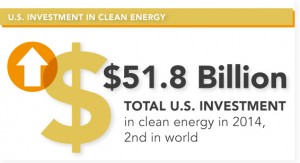
Bloomberg New Energy Finance has just released its 2015 Sustainable Energy in America Factbook prepared for the Business Council for Sustainable Energy. The report shows that on any number of metrics, progress in clean energy has really been immense for at least three reasons:
First, the United States overall invested nearly $400 billion in clean energy since 2007. The United States still fell short of China in total clean energy investment last year, but compared with 2004, investment last year in this sector was higher by a factor of five.
Second, economic growth itself is getting cleaner. The U.S. economy has rebounded strongly from the 2008 – 2009 economic downturn. Growth has led to more energy use and more greenhouse gas emissions. And indeed, carbon emissions have started rising again. But overall, Bloomberg reports that the energy productivity of the U.S. economy continues to improve. From 2007 to 2014, electricity demand has been flat despite the economic rebound. Over the same time period, carbon emissions coming from the energy sector declined by 9%.
Third, wind and solar “have achieved liftoff.” In 2007, renewable energy provided just 7% of the nation’s total energy. By 2014 it had nearly doubled to 13%. Much of this has been driven by the two most successful sectors, wind and solar. Those two have more than tripled in capacity since 2008. And as this has happened, wind and solar have become increasingly cost-competitive: “Wind energy is the lowest cost option for utilities in some parts of the U.S., and solar energy beats the retail electricity price paid by homeowners in many states.” (Other clean energy sectors, such as geothermal and hydropower, haven’t seen the same dramatic growth.)
Solar Industry Employs 173,807 Americans
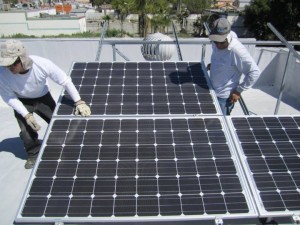 That’s more than the coal mining – 93,185 jobs – and represents an 86% growth rate in four years, and 22% growth rate this past year, adding 31,000 new jobs to the economy. Those are the findings of The Solar Foundation, an independent nonprofit solar research and education organization that has released its fifth annual National Solar Jobs Census.
That’s more than the coal mining – 93,185 jobs – and represents an 86% growth rate in four years, and 22% growth rate this past year, adding 31,000 new jobs to the economy. Those are the findings of The Solar Foundation, an independent nonprofit solar research and education organization that has released its fifth annual National Solar Jobs Census.
Solar employment grew nearly 20 times faster than the national average employment growth rate of 1.1%. The findings reveal that one out of every 78 new jobs created in the U.S. over the past 12 months was created by the solar industry – 1.3% of all jobs. And for the fifth consecutive year, the solar industry is attracting highly-skilled, well-paid professionals. According to its CEO Lyndon Rive, “SolarCity is extremely proud to be the largest solar employer in the U.S., and to have added more than 4,000 new U.S. jobs in 2014.”
In California, the solar industry employs more workers than the entire workforces of the state’s major investor-owned utilities. California has more than one-third of the nation’s solar jobs, representing 47,223 workers, up 8% from 2012.
The National Solar Jobs Census 2014 was produced from data collected from more than 7,600 U.S. businesses. It measured employment growth in the solar industry between November 2013 and November 2014 with a margin of error of +/-2.03%. Of particular interest to the researchers was the continued high wages among solar installers. They also found that the solar installation sector is generally more diverse than other energy sectors, hiring more African-Americans and Latinos than the oil, gas, coal and construction sectors.
The full National Solar Jobs Census report is available at http://TheSolarFoundation.org
Blowin’ in the Wind
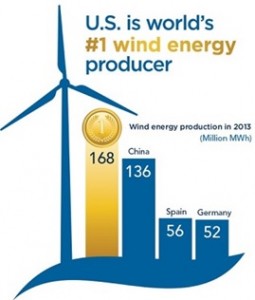 “America is number one in wind power,” stated President Obama in his State of the Union address. America produces more wind power than any other country in the world. And “being #1 in wind power means that we, as energy consumers, are gaining greater access to clean, homegrown, affordable power.” The U.S. Department of Energy estimates that our wind energy potential is 10 times the amount of electricity consumption for the entire country.
“America is number one in wind power,” stated President Obama in his State of the Union address. America produces more wind power than any other country in the world. And “being #1 in wind power means that we, as energy consumers, are gaining greater access to clean, homegrown, affordable power.” The U.S. Department of Energy estimates that our wind energy potential is 10 times the amount of electricity consumption for the entire country.
In 2013, America produced 168 million MWh of wind power, more than China at 136 million MWh, and three times more than Spain and Germany. And new wind energy capacity quadrupled in 2014, according to a report by the American Wind Energy Association (AWEA). A total of 4,850 megawatts of capacity was installed last year.
There are a number of reasons for U.S. preeminence: Experts claim that we have the most productive wind turbines in the world. Taller towers and longer blades have made wind turbines more efficient. Project developers have been smart about siting the turbines in environmentally friendly and wind resource-rich locations. Thus, our turbines are nearly twice as productive as those in China and Germany. And we’ve had a policy incentive that rewards electricity production. The Production Tax Credit (PTC) has offered tax relief to projects based on how much power they produce.
In related news:
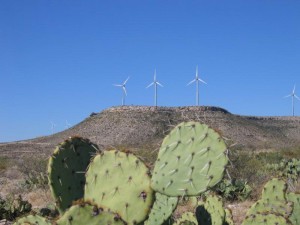
Desert Sky Wind Farm, Texas
Texas: Wind-generated power represented 10.6% of Texas’ total electricity in 2014 according to the Electric Reliability Council of Texas. In March 2014, wind energy provided 29% of the ERCOT’s total electricity. Texas’ installed wind capacity surpasses that of any other state.
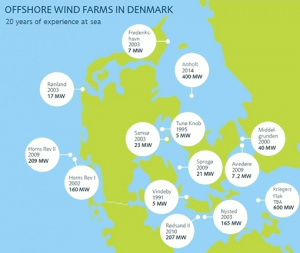
Wind in Europe: Meanwhile, wind power accounted for 43.7% of all new installed capacity in Europe. More wind power capacity was added than fossil-fueled generation last year. According to The Copenhagen Post, wind provided 39% of the country’s total electricity in 2014. Denmark is on track to reach its 50% wind goal by 2020.

Wind turbine in Brooklyn
New York City: The first large-scale wind turbine has been installed in New York City. The 160-foot turbine will produce power for a recycling facility that already gets 16% of its power from the sun. The plant owned by Australian Sims Metal Management is located on a pier at the South Brooklyn Marine Terminal. It has processed most of the city’s curbside metal, glass and plastic recyclables since opening in 2013. At a ribbon-cutting ceremony, General Manager Thomas Outerbridge spoke about the sometimes arduous, four-year process of turning windblown dreams into reality. “They say, ‘If you can do it in New York, you can do it anywhere.”
Steady winds can be difficult to find in New York, where breezes can blow at around 3 mph and gusts can rage at 30 mph. Steady winds of at least 10 miles per hour are required for the new turbine’s blades to spin; the spinning stops when winds reach 55 mph. Density of development in cities is another obstacle, often blocking or tunneling wind. The Sunset Park waterfront’s wide-open nature makes it a prime spot for harvesting wind. Prevailing winds come from the west at an average annual speed of 11.85 mph.
Tipping Point
The other day I saw a man carrying a suitcase, no wheelies. That’s now a novelty. On a par with wristband drones that boomerang off one’s wrist to get a valued shot.

Speaking of novelties, the past month was full of firsts, perhaps some tipping points: Two guys free-climb El Capitan over 18 days. Sure they had safety ropes, and used them, and made it.
Talk about reaching to new heights; what a wonderful world. Gasoline prices below $2 a gallon? That’s amazing and a bit troubling.

Carl’s Jr. now offers its All-Natural Burger at all 1,150 stores. That’s USDA-defined “all natural.” The All-Natural Burger is grass-fed, free-range charbroiled beef (from Down Under – due to domestic supply limitations), with no hormones, steroids, or antibiotics.
A tipping point? Perhaps. All fast food restaurants – McDonalds, http://www.health-canada-pharmacy.com/hair-loss.html Burger King, In ‘n Out, etc. — will likely follow suit within a few years. Hats off to Carl’s Jr. Its sister company, Hardees, will test “all natural” in the Midwest soon.
When test-marketed in Los Angeles, Carl’s Jr found that its 60% more expensive All Natural Burgers were received with high ratings, especially on repeat purchases. But critics encourage consumers not to confuse “grass fed” with healthy. The All Natural Burger is packed with 760 calories and 44 grams of fat. Reportedly Chipotle and Panera have been making waves with their “Better-For-You” menus.

And here’s a claim that would be hard to refute, and equally hard to believe: Each year Americans dispose of toilet paper tubes equivalent in gross volume to two Empire State Buildings. Now Scott is making a tubeless toilet paper roll. Who needs tubes?
USDA Updates the Food Pyramid
The U.S. Department of Agriculture is the federal agency in charge of nutrition. It Center for Nutrition Policy and Promotion has mounted decades of campaigns encouraging Americans to eat healthy.

In the 1940s USDA promoted its “Guide to Good Eating;” in the late 50s through the 70s it was all about “Food and Fitness.” Then there was the “Food Wheel” in the 1980s, followed by the 1992 “Food Pyramid,” which was then eclipsed by “MyPryamid” in 2005, only to again be upstaged in 2014 with “MyPlate”… a colorful palate showing that healthy eating is a blend of all food groups, with more of some and less of others.

The federal government has now broached the linkage between food and climate… specifically beef production and greenhouse gases. Cattle not only belch greenhouse gases, but also trample soils and require massive amounts of water. The cattle industry is reportedly hopping mad, claiming “an anti-meat agenda.” Stay tuned. And an article in Time Magazine questions whether the Obama administration “has the stomach to tackle food while battling coal plants, methane emissions from oil and gas extraction, and automobile efficiency.”
Federal agencies are going green in many ways: The military has green jets, HUD has green building, and the Department of Education is promoting climate change education and action. The Department claims that it is time for food – especially the food served to school children — to be prioritized in line with climate protection. Given the nation’s obesity epidemic, the shape of school lunches and food assistance services now needs to focus on this nexus between personal health and public benefit.

So now classic food thinking is being updated with an environmental parameter. It’s not just about what is good for people. Cookies are not so bad for the planet, but can have serious health consequences for people. Meat, on the other hand, is neither healthy nor good for the planet. Now the federal government is encouraging both in moderation.
Quantifying Campus Sustainability
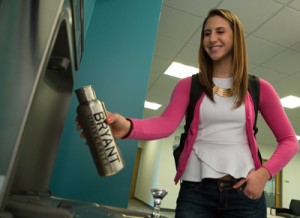 EcoMotion has recently finalized Bryant University’s Second Sustainability Plan. The revised Plan features sustainability metrics. Guided by Bryant’s Chief Financial Officer, the Plan uses weather and student-count normalized data to gauge progress on a host of sustainability goals, from energy to water use and the food procured and served in the dining hall.
EcoMotion has recently finalized Bryant University’s Second Sustainability Plan. The revised Plan features sustainability metrics. Guided by Bryant’s Chief Financial Officer, the Plan uses weather and student-count normalized data to gauge progress on a host of sustainability goals, from energy to water use and the food procured and served in the dining hall.
The Plan provides background on past and current initiatives, outlines strategic goals, and reports on current metrics across ten domains. The domains include academics and research, energy, buildings and land use, health and wellness, transportation, waste reduction and recycling, water, community engagement, food and dining, and supply chain management.
The most unique aspect of Bryant’s latest Sustainability Plan is its robust implementation tracking system. The user-friendly table assists stakeholders in tracking the goals for which they are responsible with the corresponding domain, goal description, metric, and year.
While Bryant is keen on environmental stewardship, the Plan serves as a quantifiable document to guide programs and initiatives. EcoMotion is helping the university achieve its sustainability goals with some precision and measurability. Barry Morrison, CFO, has been driving the effort and to his credit… the university is saving money while fostering stewardship.
The Sustainability Plan serves as a road map. It is a testament to the University’s commitment to becoming a more sustainable campus community across operations, engagement, and academics. The Plan aims to mitigate adverse campus impacts, amplify constructive practices, while fostering innovation on and off campus.
The Plan also features a $16,378,638 investment list that documents steps taken on campus to achieve sustainability goals. The majority of the investments were energy efficiency upgrades.
This past year, EcoMotion also guided Bryant in securing its new dining service contract. Strict sustainability criteria were introduced to select a provider whose principles are aligned with the University’s.
To view the Sustainability Plan 2 please visit: www.bryant.edu/about/sustainability
The Closure of Vermont Yankee
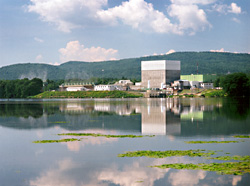
Vermont Yankee set to close
Falling prices of natural gas are cited as the primary reason that Entergy has finally pulled the plug on Vermont Yankee. The 605 MW nuclear reactor located in Vernon, Vermont, the southeast corner of the state, was commissioned in 1972. After forty-two years it has now reached the end of its economic life. The plant’s operator, Entergy, is prepared to pay its $1.2 billion decommissioning bill.
Vermont Yankee was the target of years of protests and lawsuits by state officials, environmentalists, and others concerned about safety and radioactive wastes. But that’s not what shut the plant. Instead, with plant upgrades complete and an operating license in hand until 2032, Entergy pulled the plug because it was uneconomic to operate given the glut of inexpensive natural gas on the market. Of the nation’s fleet of ~100 nuclear reactors, five have closed since 2012 due to economics driven by costly repairs and inexpensive natural gas.
An article in the New York Times presents countervailing views. A Vernon selectman laments the loss of “a best friend;” the plant employed 550 people and pumped hundreds of millions of dollars into the local economy. To some residents of the area, Yankee has been “the kindly reactor next door.” Others are pleased to return the bucolic rolling hills of Vermont to their pre-nuclear state. But they know full well that Vernon remains saddled with high-level nuclear wastes.
Electric Utility Buys Solar Company
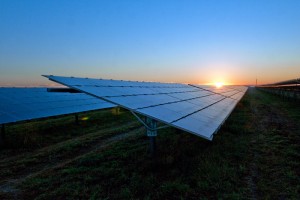
Blue Wing Solar Farm, San Antonio
Duke Energy just acquired a majority stake in commercial solar installer REC Solar and is ready to invest up to $225 million in REC’s solar projects. And Duke is not alone: Recent utility moves into commercial solar include NextEra’s acquisition of Smart Energy Capital, NRG’s formation of Sunora Energy and Edison International’s purchase of SoCore.
Based in San Luis Obispo, REC Solar provides a sales and financing process for commercial-scale customers and has installed more than 440 U.S. commercial systems, with a total of more than 140 megawatts installed and under development. Duke Energy Renewables has a commercial renewable portfolio totaling about 1,800 megawatts of solar and wind capacity. “Duke Energy owns more than 500 megawatts of solar projects, most of which are in North Carolina and range from 1 megawatt to 85 megawatts.
The Duke investment speaks to solar industry consolidation, some say in preparation for the expiration of the 30% Investment Tax Credit (ITC). An REC official noted, “As the ITC expires, your cost structure is going to matter a lot.” REC is focused on simplified customer financing, including leases and power-purchase agreements. He suggested that the same business-process savings that residential solar has gone through are happening now in commercial, such as more standardized documentation and better business flow.
REC Solar benefits from Duke Energy Renewables’ low cost of capital, while Duke gets to take a stab at the commercial solar market by leveraging REC Solar’s longstanding experience at originating and developing smaller and mid-scale commercial projects. REC Solar will be the entity doing the development work. Duke’s role is to finance and sell the power or lease the project to the end user.
What’s Up at EcoMotion?

5th and Grand
New Headquarters: First off, we’ve moved our headquarters from the California Endowment to One Bunker Hill in downtown Los Angeles. Our offices are the historic Southern California Edison headquarters, across the street from the library and the Biltmore at Pershing Square. Come on down and visit.

Welcome New Staff: Codi Leitner has joined EcoMotion in California. Focusing on Business Development she and Drew Lowell-Britt recently attended a two-day Community Based Social Marketing Workshop at TreePeople thanks to the City of Santa Monica.
Lecturing on Solar Friendly Rates: In January, Michael Ware served as guest lecturer for an EUCI Conference (Electric Utility Consultants, Inc.) in Garden Grove. He presented customers’ viewpoints on “solar friendly rates.” The conference was attended by utility officials, attorneys, and energy experts from across the country. (In October, Michael and Troy Strand presented at another EUCI Conference in Newport Beach on the topic of solar PPA due diligence.)
“Ask the Expert about Solar!” In a brand new arrangement, EcoMotion’s Senior Solar Specialist, Michael Ware, now serves as the Green Schools Alliance solar expert. Any member of the Alliance can call with questions for no cost solar advice. In addition, EcoMotion provides initial solar consultation to all AASHE member schools.
AASHE Advisory Council: Speaking of AASHE, Director of Campus Services, Sierra Flanigan, has been appointed to AASHE’s prestigious Advisory Council. As such, EcoMotion will continue to support AASHE as a broad and effective platform for campus sustainability, coast to coast.
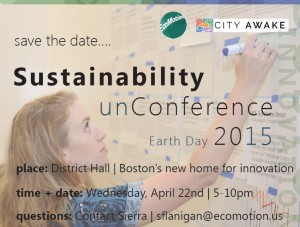
Upcoming New England Conferences: EcoMotion’s Campus Services Division is preparing for two important events this spring. First off is the Northeast Campus Sustainability Consortium Conference. In partnership with Earthos Institute, Princeton University, and MIT, EcoMotion is playing a pivotal organizing role in the April 9 – 10 conference at UMass Amherst. Then later in April, EcoMotion will be hosting the Third Annual Sustainability unConference. It will be held at District Hall in Boston on Earth Day.

Port of Long Beach: EcoMotion is working as a subcontractor to TRC Solutions for the Port of Long Beach. One of the nation’s busiest ports, it was recently rated as the greenest port in the world. EcoMotion’s first assignment is a study of the Port’s current solar potential, with a vision of future solar potential to meet the Port’s Green Port goals.
Prop 39 News: EcoMotion spearheaded the successful submittal of Poway Unified School District’s Energy Expenditure Plan. Approved in record time, the Plan allows for major retrofit activity at four school sites, retrofitting lamps, retro-commissioning control systems, energy dashboards, pool pumps and covers, and more. In Garden Grove, EcoMotion is finalizing the District’s first submittal, a double plan focused on five schools and using the CEC’s new Prop 39 Guidelines. EcoMotion has also prepared each district’s Five Year Smart Energy Management Plan, a broad roadmap for maximizing energy, environmental, and economic efficiency on campus.
CleanTech San Diego: Thanks to an invitation by the Poway Unified School District, Ted Flanigan and Thelma Rodrigues-Winter recently spoke about the Prop 39 experience in Poway and our successful double submittal at CleanTech San Diego’s K-12 Collaborative. The K-12 Collaborative is expertly facilitated by Marty Turock and meets monthly at San Diego Gas and Electric’s double LEED Platinum Energy Innovation Center. The Center opened in 2011, refashioning a supermarket built in the 1950s into a world-class center for progressive energy management.
Breaking News… Energy Savings Agreements
 EcoMotion is working with RENEW Energy Partners to promote Energy Service Agreements (“ESAs”) as a means of expediting energy efficiency and sustainability programs, beginning in New England. Akin to power purchase agreements (PPAs) for solar systems, the ESA provides a powerful means for schools and universities to accomplish and accelerate energy efficiency programs. An ESA provides a customer with a turnkey energy systems retrofit solution in their facilities with no upfront capital outlay, an immediate reduction in annual operating costs, all necessary warranty and maintenance covered, and the opportunity for off-balance sheet treatment of the service payments. RENEW will not only fund efficiency upgrades, but will identify them and will project manage complex retrofits on clients’ behalf. For more information on ESAs applicable to projects on both the East and West coasts, contact Ted Flanigan at EcoMotion.
EcoMotion is working with RENEW Energy Partners to promote Energy Service Agreements (“ESAs”) as a means of expediting energy efficiency and sustainability programs, beginning in New England. Akin to power purchase agreements (PPAs) for solar systems, the ESA provides a powerful means for schools and universities to accomplish and accelerate energy efficiency programs. An ESA provides a customer with a turnkey energy systems retrofit solution in their facilities with no upfront capital outlay, an immediate reduction in annual operating costs, all necessary warranty and maintenance covered, and the opportunity for off-balance sheet treatment of the service payments. RENEW will not only fund efficiency upgrades, but will identify them and will project manage complex retrofits on clients’ behalf. For more information on ESAs applicable to projects on both the East and West coasts, contact Ted Flanigan at EcoMotion.